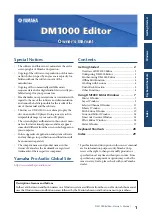
6.39
Mallet
97
res=1
res=0.5
res=0.1
res=0.02
cutoff
frequency
frequency
Hz
-12dB/Oct
amp
dB
Figure 47: Frequency response of a Lowpass2.
6.39
Mallet
The Mallet module is used to simulate the force impact produced by a
mallet striking a structure. It is usually used in combination with acoustic
objects such as the Beam, Membrane, Plate and String modules in order to
play them. The force of the impact is adjusted with the strength knob while
the stiffness of the mallet (related to its material) is varied with the stiffness
knob. Figure 30 shows the effect of the adjustment of the stiffness on the
output signal. As the stiffness is increased the excitation signal becomes nar-
rower. The effect of the strength parameter which determines the amplitude
of the impact is also shown in the same figure.
strength=0.2
strength=0.5
strength=1
stiffness=50
stiffness=500
stifness=5000
time
time
amp
amp
Figure 48: Effect of stiffness and strength knob on Mallet output.
This module has one output, the impact signal, and four inputs. The first input triggers the
mallet every time a low-to-high transition is encountered in the input signal. This input is usually
connected to the gate signal from a Keyboard module. Note that the mallet can also be trig-
gered manually by using the trig button on the front panel. The second input signal modulates the
stiffness of the mallet relative to the value selected with the stiffness knob. The amplitude of the
modulation is adjusted with the mod1 knob. The greater the amplitude, the greater the stiffness.
This modulation input is used, for example, when a variation of the stiffness of the mallet with
the note played is desired. When the knob is adjusted in its center position and when this input
Содержание TASSMAN
Страница 1: ...USER MANUAL ...
















































